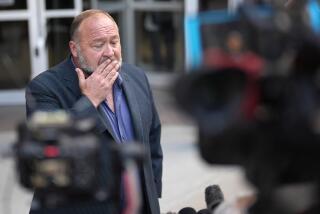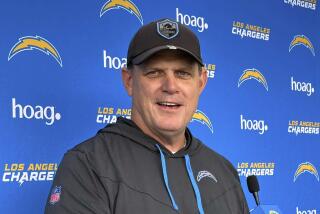Despite Legal Problems, Firm Turns Aggressive in Marketing New Products : A Leaner Smith International Is Back in Fighting Trim
- Share via
At the recent Offshore Technology Conference in Houston, where the world’s oil service companies show off their latest wares, Smith International hosted one of the biggest and brightest exhibits.
“I was shocked,” said Jeffrey Freedman, a longtime Smith watcher who follows the industry for the investment firm of Smith Barney, Harris Upham & Co. “I expected to see a tiny thing from Smith and there they were, front and center, with the biggest display.”
Just 14 months after filing for bankruptcy to protect itself from a $205-million judgment won by archrival Hughes Tool, Newport Beach-based Smith has emerged from the shadows.
The new, lean Smith has shrunk from 10 divisions to three and has a corporate staff of 42, down from 117 a year ago.
Despite a $149-million loss in fiscal 1986, Smith executives predict a profitable first quarter for 1987. The company has $150 million in cash on hand, and Smith’s stock price has climbed from a low of $1.50 a share a year ago to $5.25 on Friday.
Court Eases Burden
The burden of seven separate appeals filed by Hughes was lifted Thursday when a bankruptcy judge dismissed them all.
And, Smith continues to negotiate a reduced settlement of the $205-million patent infringement award with Hughes Tool, which recently merged with Baker International and became Baker-Hughes.
Although conscious of disastrous market conditions and burdened by the weight of its legal problems, Smith is aggressively marketing a line of new oil industry products and planning for its future.
“Most analysts see us as a survivor,” Chief Financial Officer Loren K. Carroll said.
Indeed, industry analysts said Smith’s bold approach at the trade show and its new line of drilling equipment reflects the confidence gained from surviving the worst year in its corporate history.
Still, some analysts now question whether Smith can remain independent in a shrinking universe of oil services companies. But that question won’t have to be answered until Smith emerges from its Chapter 11 reorganization.
Smith’s horrendous year began in February, 1986, when the company lost its acrimonious 14-year patent infringement battle to Houston-based Hughes Tool.
A Los Angeles federal judge ruled that Smith’s infringement of Hughes’ patented drill bit technology was worth $205 million, among the largest damage awards in U.S. history.
A few days later, seeking to protect its assets from seizure during the appeals process, Smith filed for protection under Chapter 11 of the U.S. Bankruptcy Code.
Outside the Los Angeles federal courthouse, 1986 was not much better for Smith. For the year ended Dec. 31. Smith suffered a $149-million net loss on revenue of $415.2 million. At its peak in 1981, Smith reported net income of $133.1 million on $1.2 billion in revenue.
Sales to Smith’s primary customers--oil companies--plunged after a worldwide oil glut forced oil prices to a low of about $10 a barrel by early 1986.
At those depressed prices, oil companies stopped drilling, and the number of drilling rigs active in the United States plummeted 59% to 896. In response to all these factors, Smith slashed its worldwide work force to 3,100 from 7,400 and sold 87% of its U.S. manufacturing capacity.
Staff Cut Sharply
Today, Smith Chairman Jerry W. Neely cheerfully says the staff is so lean that there are only three people between him and the customer.
“You can’t say ‘poor us’ when everybody else is in the same boat (market-wise),” Neely said last week in his first lengthy interview in more than a year.
Neely said he spends his time supervising day-to-day business operations, while Carroll deals primarily with the bankruptcy proceedings.
“I try to make everybody feel they have a stake in this,” said Neely, who meets frequently with his division managers and employees to boost morale. “Our customers have been very supportive, and our suppliers are standing by us.”
He said the remaining Smith employees are a loyal, close-knit group who believe in the company’s future.
When asked how he has hung on through adversity, he thought for a moment and replied: “You either quit and leave, or deal with the realities of life.”
Neely, who earns $300,000 a year, acknowledged that it is sometimes difficult to concentrate on the business at hand while worrying about the $205-million Hughes judgment.
A federal appeals court in Washington is expected to make a decision soon on whether to uphold the district court’s judgment.
Has Some Alternatives
Even if a multimillion-dollar judgment is upheld, Neely said, Smith has alternatives “and none suggest you just give (Baker-Hughes) the keys (to Smith).”
He said any reorganization must be fair to all the creditors, not just Baker Hughes.
Smith executives said they welcomed the recent merger of Baker and Hughes because Smith and Baker have always had a cordial relationship. Baker had been based in nearby Orange until moving its headquarters to Houston last March.
Baker officials have been acting as intermediaries in negotiations between Smith and Hughes for months. Carroll has attended several meetings in Orange County, Texas and New York.
Carroll said he is cautiously optimistic about reaching an agreement. He said Smith believes that $10 million would be an appropriate settlement for its infringement of the Hughes’ patent.
“I would be hopeful that with Baker being very well managed, there may be a settlement,” said Carroll, who carries a half dollar-size rubber O ring in his briefcase. It is the small rubber device that was at the center of the patent infringement litigation.
“We honestly believe it is not possible to patent an ‘O’ ring,” Carroll said, offering the ring to a visitor.
He said the acrimony between Hughes and Smith stretches back 30 years or more, beginning with a clash in corporate culture and Hughes’ original product dominance in the Oil Patch.
The hatred spilled into bankruptcy court this year, when Hughes filed seven appeals, objecting to virtually every action approved by U.S. Bankruptcy Judge James R. Dooley in Los Angeles.
“Hughes fights everything,” Carroll said . “It’s harassment, nothing more than that.”
But apparently Baker’s influence has already been felt. Last Thursday, Dooley dismissed all seven Hughes appeals at the request of both Smith and Baker Hughes.
Sources close to the case said the decision to drop the appeals was made by the Baker executives now working at Hughes. After the ruling, attorneys for Smith and its unsecured creditors’ committee said they welcomed the action because it will save them a lot of time and money.
Meanwhile, Smith executives say they are confident that the company will emerge from bankruptcy stronger and wiser. “We have a hell of a lot of cash,” Carroll said, expressing optimism despite the large 1986 losses.
Still, Smith executives are not ordering champagne.
In addition to the estimated $450 million that Smith owes to all its creditors, including Hughes, Smith is battling a $21-million claim recently filed by the Internal Revenue Service for back taxes from 1980 to 1985. Smith disputes the claim.
Costly Proceedings
And being in bankruptcy proceedings creates more work and expenses for the beleaguered company. Carroll said Smith spends about $6 million a year on attorney and consulting fees relating to the bankruptcy.
Each Friday, Carroll must submit a voluminous financial report to the court. And he spends hours providing detailed information to the various creditor’s committees.
So far, he said, the relationship with Smith’s bankers and others has been “cordial.” Bernard Shapiro, an attorney representing the court-appointed unsecured creditors’ committee agreed.
“The relationship with Smith has been very professional, cordial and constructive,” Shapiro said. “When the current oil (drilling) crisis is over, the creditors hope Smith will emerge as a strong competitor.”
Smith has until June 30 to submit a reorganization plan to the bankruptcy court. If it does not meet that deadline, the creditors may submit a plan of their own, Shapiro said.
With the legal dust settling and the stock price rising, Smith has some breathing space to ponder the future. Smith executives say they would like Smith to maintain its corporate independence, but some Wall Street analysts are skeptical.
Expects Takeover
“I can’t see the company remaining independent,” said Philip K. Meyer, an oil industry analyst for the Dillon Read investment firm in New York. “The ultimate resolution is that it has to be bought out.”
Meyer said a likely suitor might be Halliburton, a Dallas-based oil field services company. But Meyer and others said Smith’s current bankruptcy proceedings have deterred any serious takeover prospects, at least for the moment.
Other analysts are more confident that Smith can make it alone.
“They probably are not going through all this to be snapped up,” said Kevin Simpson, an oil services industry analyst for Drexel Burnham Lambert in New York.
“Smith could be spectacular by itself,” if the oil drilling industry makes a full recovery, he said.
Meanwhile, analysts agreed that the unknown quantity in Smith’s future is its largest individual stockholder.
Industrial Equity (Pacific) Ltd., a New Zealand investment firm, has a 15.2% stake. So far, Carroll said, Industrial Equity has not discussed any specific plans for Smith, but “anything’s possible.”
Ronald Langley, president of Industrial Equity’s North American operations, sits on Smith’s board and his company is seeking a second board seat.
Langley was out of the country last week and unavailable for comment.
“We have a good working relationship with Langley,” Carroll said. “They are clearly a friendly company.”
More to Read
Inside the business of entertainment
The Wide Shot brings you news, analysis and insights on everything from streaming wars to production — and what it all means for the future.
You may occasionally receive promotional content from the Los Angeles Times.










